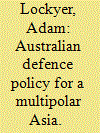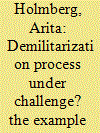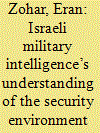| Srl | Item |
| 1 |
ID:
141786


|
|
|
|
|
| Summary/Abstract |
There is a growing consensus among defence planners that Australia is in need of a new defence policy that better suits the strategic realties of an emerging multipolar Asia. After assessing the implications of shifting regional power balances for Australia, this article advances the argument that Australia should redirect its attention back to its immediate north: the “Indo-Pacific Arc”. Indonesia, Singapore and Malaysia have always been vitally important to Australia’s long-term security and, being the gateway between the Indian and Pacific oceans, their strategic value is set to dramatically increase in the multipolar Asia. Finally, this article develops the case for Australia to partner with its neighbours to stem the political and military influence of outside powers into the Indo-Pacific Arc.
|
|
|
|
|
|
|
|
|
|
|
|
|
|
|
|
| 2 |
ID:
141785


|
|
|
|
|
| Summary/Abstract |
The formal model of modern-system force employment developed in Stephen Biddle (2004) book, Military Power, is a standard text in the defense analysis field but has rarely been applied to analyze battlefield outcomes. The 2008 Five-Day War between Russia and the Republic of Georgia provides a compelling case study for empirical testing. The outcome of the conflict reveals an inconsistency between the theoretical model and the actual results, suggesting that technical and tactical force employment variables alone may not be sufficient to explain battlefield dynamics, and that the effects of psychological shock on unit morale and cohesion may constrain how well a military force can perform even while adhering to modern-system doctrine.
|
|
|
|
|
|
|
|
|
|
|
|
|
|
|
|
| 3 |
ID:
141784


|
|
|
|
|
| Summary/Abstract |
During the past decades, the process of militarization that characterized Sweden after the Second World War has been replaced by a process of demilitarization. With the debates following the war in Georgia 2008 and the Russian annexation of Crimea in 2014, this process of demilitarization appears under challenge. This raises questions about the nature of these processes and the problems facing the attempts at turning them around. The article introduces a framework for analysing the influence of the military upon politics and society in the twenty-first-century European context with the aim of better understanding the various traits, their interconnections and relation to broader trends in Europe and the West. The analysis shows that traits of demilitarization are still dominating in Sweden, although some indications of remilitarization can be found.
|
|
|
|
|
|
|
|
|
|
|
|
|
|
|
|
| 4 |
ID:
141783


|
|
|
|
|
| Summary/Abstract |
The Arab Awakening was a strategic surprise for the Israeli military intelligence (AMAN), but did not cause immediate damage for the security of Israel because of the internal character of events. At an early stage AMAN recognized the general direction of the upheavals, which were more conflicts rather than the establishment of a democratic new order in the Middle East. The Arab Awakening operated as an intervening factor, escalating some of Israel’s major security challenges and de-escalating others. AMAN provided strategic intelligence warnings (of Iran’s military nuclear plan) and actionable intelligence (about Hezbollah’s infrastructure across the Syrian border), but presumed to assess the stability of regimes in a chaotic environment (Egypt, Syria), faced difficulties in monitoring capabilities of new actors (ISIS) and intentions of adversaries (Hamas). Fighting Hamas and Hezbollah, AMAN might subordinate itself to the strategy of deterrence rather than defeating the enemy. AMAN’s chiefs viewed the Arab Awakening as a facilitator to implement an unbalanced intelligence concept focusing on “shaping reality”, undermining the strategic analysis that must remain central to intelligence work.
|
|
|
|
|
|
|
|
|
|
|
|
|
|
|
|